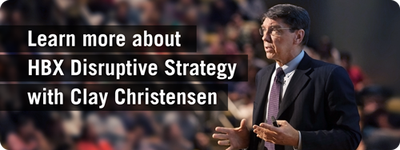
Taking the Disruptive Strategy with Clayton Christensen course was the first introduction I had to the idea of “jobs to be done.” Professor Christensen's theory essentially explains that people “hire” different products to do “jobs” that they need done. Sounds easy enough, right?
That’s what I thought, too. But, the more I thought about it, the more I realized that I didn’t really understand it. Certainly, things in the course helped me better grasp the concept. I could explain the theory to you, give you examples, but I was still missing the deeper understanding of where I could apply it to my everyday life.
I finally had my “ah-ha” moment when I was riding with my mother in the car and watching her simultaneously put on makeup, drive, and talk on the phone. Here is what I learned from this terrifying experience.
1. Observe
You can’t find jobs to be done without observing people. This was my first lesson. Maybe it was the fact that I was scared for my life. Maybe it was because I have seen many women struggle to drive and put on makeup. Whatever the reason, it was in that moment with my mom where my time spent thinking about jobs to be done clicked.
The thought popped into my head, “how could I make this easier and safer?” Then I made the important connection, what was the job to be done here? Help me put on makeup and drive safely? It was the mindset of not taking an idea and then defining a job to be done, but rather observing people and asking the important question, “how could I make this easier/cheaper/better” that led to me seeing a job to be done that my mom could hire a product for.
2. Focus on the Job, Not the Product
Upon further reflection I realized that in that moment of terror and enlightenment, I wasn’t at all worried about the product. Jobs to be done isn’t about the product; that comes later down the line. I had been so focused on the development of the end product that I missed the bigger picture. Finding the product is the end goal in most brainstorming sessions and I think, because of that, we tend to miss the bigger picture: What job are we hiring for? The product will come once the right job is found. That is the truly difficult part.
3. It is a Process
This is a process, a way of thinking. First, I had to understand the theory. I spent time with it and the cases; I thought about it while I was walking around, trying to apply what I'd learned. But, it wasn’t until my understanding of – and mindset towards – the concept had changed that I finally witnessed it firsthand with my mom. I wasn’t contemplating the theory when I was watching her, I was just sitting there with my life flashing before my eyes. But the theory had become a part of my outlook on the world, part of me, and because of that I was able to make the connection.
Maybe jobs to be done is easier than I made it out to be, but for me there was a difference between being able to explain it and find a "job to be done" for already existing products, and identifying a job to be done in real life, from which a product could be developed.
Learn more about Professor Christensen's "jobs to be done" theory HERE.
Want to learn more about "jobs to be done" and other theories from Professor Christensen? Disruptive Strategy will equip you with the tools, frameworks, and intuition to make a difference.
About the Author
Chris Larson is an intern at HBX working with the marketing and product management teams. His background is in all things Russian, but he is interested in business and will be starting his MBA at Oxford University this fall.









